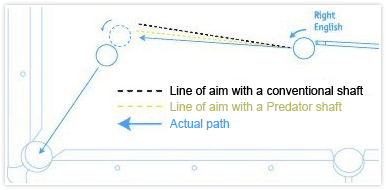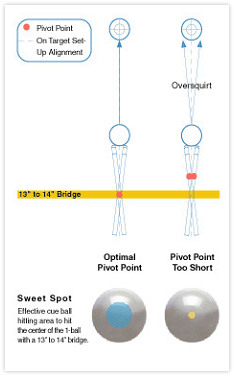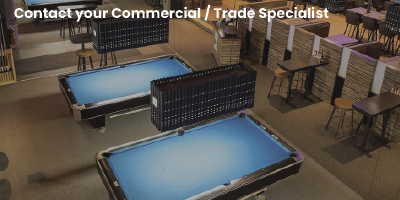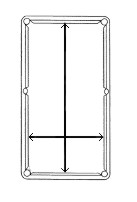Understanding Cue Ball Deflection
John Roufas2021-12-28T17:57:17-04:00Understanding Cue Ball Deflection
The vast majority of all shots are missed when “English” or sidespin is used. The reason is simple: when you use English, the cue ball doesn’t go where you aim it. That’s called “cue ball deflection” or “cue ball error” and the typical player takes years to learn to compensate for it.

The amount of cue ball deflection depends on the cue used, the tip placement and the speed of the stroke. The farther the strike from center, the more the cue ball is deflected off-line. Cue ball deflection will also increase with a faster stroke. Lower deflecting cues require less compensation and therefore make the game easier. The Predator shafts are designed to reduce cue ball deflection and are the lowest deflecting shafts on the market. They greatly increase your chances of making your shot when you use English.

About Pivot Points

More than likely, your cue’s shaft is made from wood. Wood is a porous material, and all manner of dirt and oil can get trapped in these pores, which give your shaft a sticky feel. One way of fixing this is by closing the pores of the wood by burnishing. By heating up the cue with friction the pores in the wood close, preventing pesky molecules from getting lodged in them. To do this, use a smooth piece of un-dyed leather or Cue Slicker, which can be purchased at your local billiard supplier, and rub it vigorously up and down your cue’s shaft, while at the same time turning the cue.
Products such as Q Slick negate the need of heat as it applies a sealant to the wood, effectively sealing the pores.
Are your cue tips “mushrooming”? Apply the same procedure to the edge of a leather cue tip. This should harden the tip’s outer edge and give it a clean glossy look. To accelerate the process a small drop of water can be used. Don’t have a small piece of leather handy? Use the green burnishing film from Q Smooth or a five dollar bill.
Shape Your Tip
Predator research has clearly shown that a dime radius (or shape of a dime) will produce 5 percent to 10 percent less cue ball deflection than the more commonly used nickel shape. The cue ball deflection is reduced because the dime radius centralizes the hit to the center, or strong part, of the shaft.
What burnishing does for your shaft
The purpose of burnishing your shaft is to smooth and seal the wood. The more you burnish, the better the finish and, the slicker and more moisture resistant your shaft becomes. Moisture is the #1 enemy of your shaft. It causes the grain to raise and your shaft to warp. To burnish your shaft, use a leather burnisher and avoid abrasives. Sanding your shaft wears it down and makes the wood porous, which allows moisture to penetrate the grain and damage the wood.
Stay away from abrasives
Do not use any abrasives on your shaft and stay away from green pads in Pool Rooms. Using abrasives is going to take the diameter of your shaft down and modify the shape of your taper. It may even void the warranty of your Predator shaft if the ferrule or wood diameter falls below 12.25mm for 314 shafts and 11.4mm for Z shafts. Very fine micro papers (1500 grit) or burnishing is about all you need.
Break cue weight
Contrary to what many believe, lighter is better when choosing a break cue weight. Even though a heavier break cue feels more powerful, a more powerful break will be achieved with a cue weighing 18.5 to 19 oz. Most professional players break with a cue that is 1/2 to 1 oz lighter than their playing cue because less weight allows them to generate more cue speed, resulting in greater cue ball speed and a more powerful break.
Try a Low Deflection Shaft for Yourself
All F.G. Bradley’s locations have Predator demo cues and shafts for you to try low deflection cue technology for yourself. Visit a store near you and ask a Sales Associate to help you.
This article courtesy of Predator Products.




